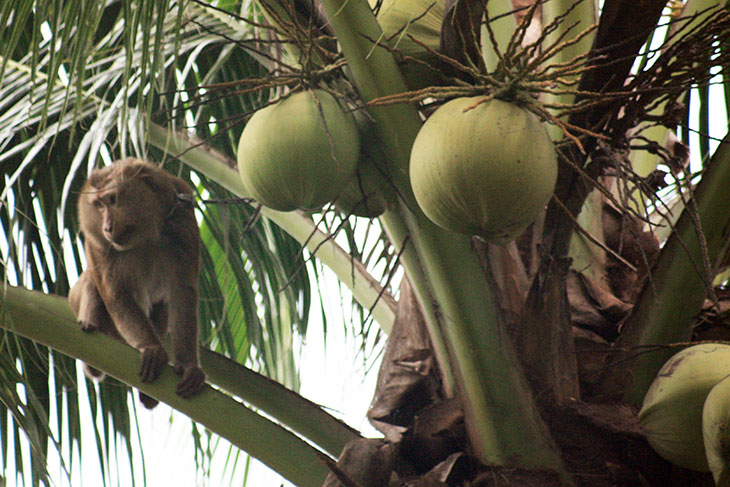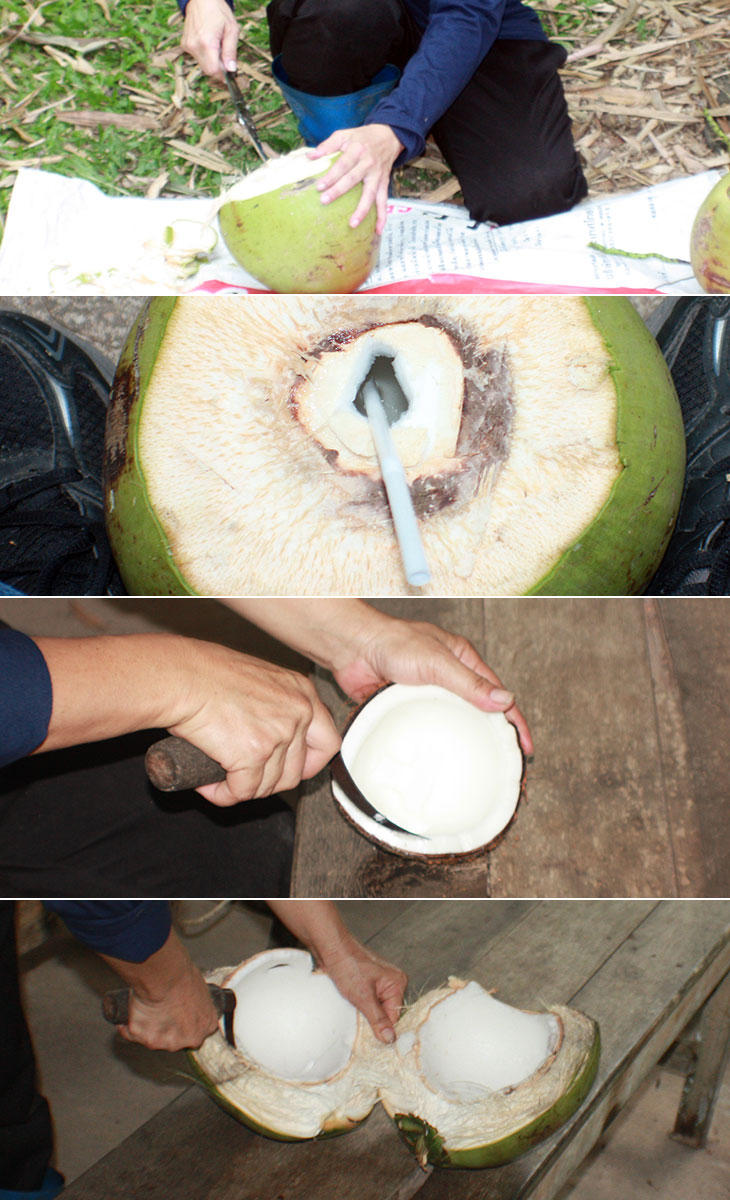…On My Best Behavior.
Why? Well, at a monkey school, I figured if I did something wrong, they might keep me for further training 🙂
But seriously, why would you train a monkey, and to do what?
Well, the Asia-Pacific region has more than a billion coconut palm trees, yielding something like 65 billion nuts per year. And although coconut-derived oils are used in everything from food and fuels to soap and cosmetics, you’ve probably never paid much attention to the fact that coconuts grow on trees.
But now that I’ve mentioned it, you’re maybe thinking of that idyllic tropical scene, with tall palm trees swaying over the beach. That’s where you’ll find coconuts. Right at the top. And if you’re lucky enough to be lazing on just such a beach, you’d be wise not to sit under the trees – no matter how tempting the shade might seem. Falling coconuts and skulls are not a good match. The latter will break first.
So now that you are visualizing those shady trees, how do you imagine the nuts are harvested? Yes, eventually the overripe nuts will fall off, and if you own the tree, maybe you’ll be lucky enough to be standing around when they do. But that’s not a very efficient method of harvesting.
So, you send your professionally-trained monkey up there to harvest the nuts for you. And that’s where Surat Thani’s monkey school comes in. Which is where I was yesterday afternoon.
It’s about ten-or-so kilometers to the east of Surat Thani city, set in very peaceful surroundings…

…and not too surprisingly they have coconut trees…

Now; if you’re a regular Twitterings reader you’re thinking “But he doesn’t like monkeys.” Very true. But hey, there’s a story here, so I had to go check it out. And here’s what I learned…

The school is operated by Khun Somjai Saekhow, and she’s being doing this for almost fifteen years. It was founded by her father, Khun Somporn Saekhow, who passed away some years ago, and she has kept the school running ever since.
It is operated very much on the principle of being kind to the monkeys, rather than beating them when they don’t work to expectations.
In fact Khun Somjai spends the first month, of the five or six needed to complete the training, making friends with a monkey.
That way, they are much more receptive to the rest of the training.

Getting a coconut to fall from a tree involves seriously twisting the stalk until it snaps. So the first real lesson is to teach the monkey to twist. (Chubby Checker fans need not apply.)
A coconut in a box is used as a training aid.
The monkeys are shown how to use their hands – and feet if they want – to spin the coconut, until the movement becomes natural to them.
At this point they’re ready to move onto some simulated coconut felling.

Holding the nut, Khun Somjai persuades the monkey to twist it a few times and then she lets go. That way the animal gets a good idea of what all the twisting is for. Later, visitors were allowed to do the same thing…

Mine decided it had to sit around for a while on my arm while it devoured a banana. Did I mention I don’t like monkeys? But no big deal. Don’t forget that by this stage of their training they’re friendly. Sort-of.
Next it was time for some rope tricks. Whether the rope was tied into a series of knots, or wrapped around several branches of a tree with the other end attached to the monkey, they could untie the knots – or themselves – almost without looking, and far faster than a human could do it…

The next picture is a well-knotted rope tied to my leg, which the monkey untied and straightened with ease…

And why do they need to learn these boy scouts’ tricks? Well, when they’re up a tree, they are linked to their owner by a long rope. This is just a training tree…

The monkeys need to move around at the top of the tree to find all the nuts, and in doing so they can easily get themselves trapped by the rope. The last thing you need to do is shimmy up the tree to untangle your monkey. Much better if the monkeys can figure that out for themselves.
Well, that was hard work, time for a break…

And of course, trees don’t come to monkeys, monkeys have to go to trees, so being comfortable with motorized transportation is all part of the training…

By this point, a few months into the training, it’s time for The Really Big Trees…

You’ll notice that now there’s no rope above the monkey to stop her falling. She’s on her own. (And I’ve switched genders to indicate that both male and female monkeys can be trained.) The rope is only used to guide the animal to the coconuts, and to give a gentle reminder that – Hey, you’re not up there to look at the view…

So, here’s some real work taking place…


Well, that’s enough for one day…

Time to tidy up…

And time for visitors to eat and drink coconuts…

 An interesting afternoon. I still don’t like monkeys, but I do understand them a little better. If you’re in the area, I’d recommend a visit. You’ll find them on the web. Call or e-mail to make a reservation.
An interesting afternoon. I still don’t like monkeys, but I do understand them a little better. If you’re in the area, I’d recommend a visit. You’ll find them on the web. Call or e-mail to make a reservation.

